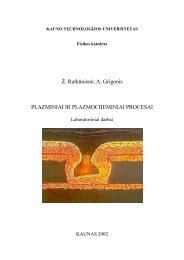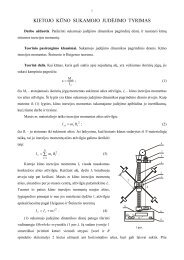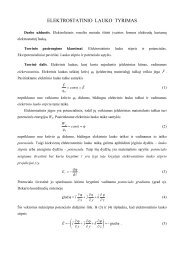PROCEEDINGS OF THE 7 INTERNATIONAL ... - Fizika
PROCEEDINGS OF THE 7 INTERNATIONAL ... - Fizika
PROCEEDINGS OF THE 7 INTERNATIONAL ... - Fizika
You also want an ePaper? Increase the reach of your titles
YUMPU automatically turns print PDFs into web optimized ePapers that Google loves.
J. Laurikaitienė et al. / Medical Physics in the Baltic States 7 (2009) 117 - 120<br />
determined by elastic-recoil detection analysis (ERDA)<br />
using primary ion beam of 2.0 MeV He + ions.<br />
Surface morphology of the films was investigated by<br />
atomic force microscope (AFM) NANOTOP-206.<br />
Measurements were performed in tapping mode using<br />
V-shaped ultra sharp Si cantilever tip with the radius of<br />
curvature less than 10 nm. Applied force constant was<br />
1.5 N/m.<br />
3. Results and discussions<br />
Optical properties of DLC films were analyzed before<br />
and after irradiation of samples. Ellipsometric<br />
measurements have shown the decreasing tendency of<br />
the refractive index and increasing transparency (Fig.1)<br />
in all irradiated samples as compared to initial samples.<br />
It is interesting to note, that the increase of the optical<br />
transparency after the first irradiation of samples, has a<br />
tendency to decrease after further irradiation. According<br />
to the authors [21] optical properties are related to the<br />
hydrogen content and density of the DLC films. We<br />
have found that samples with a lower density, and<br />
higher H content were more transparent in wavelength<br />
range 200-900 nm after the irradiation. This fits well<br />
with the results of other authors, where the similar<br />
relationship between the transparency and hydrogen<br />
content in DLC was indicated [8].<br />
Transmittance, %<br />
60<br />
50<br />
40<br />
30<br />
20<br />
10<br />
No. 1 before and after irradiation<br />
0<br />
200 300 400 500 600 700 800<br />
Wave length, nm<br />
Fig. 1. Transmittance spectra of DLC film No. 1 before<br />
(0 – 0 Gy) and after (1 – 2 Gy, 2 – 4 Gy, 3 – 6 Gy, 4 – 8<br />
Gy) irradiation with high energy photons<br />
Close relationship between changes of the optical band<br />
gap (determined as Tauc gap) after the irradiation and<br />
the hydrogen content was found as well (Fig.2), since<br />
the hydrogen content in all as prepared samples was<br />
different.<br />
2<br />
6<br />
4<br />
8<br />
0<br />
118<br />
(αE) 1/2 , (eV/cm) 1/2<br />
8x10 5<br />
7x10 5<br />
6x10 5<br />
5x10 5<br />
4x10 5<br />
3x10 5<br />
2x10 5<br />
1x10 5<br />
0<br />
No. 5<br />
before irradiation<br />
after irradiation<br />
0.5 1.0 1.5 2.0 2.5 3.0 3.5 4.0 4.5 5.0<br />
Energy, eV<br />
Fig. 2. DLC film No.5 before and after irradiation:<br />
(α⋅E) 1/2 dependence on photon energy E (ETauc = 1,75<br />
eV, before irradiation and ETauc = 1,90 eV, after<br />
irradiation)<br />
Increase of the optical band gap with an increase of the<br />
irradiation dose (γ photons) could be explained by the<br />
decreasing number and size of sp 2 clusters in DLC films<br />
[22] after the irradiation. On the other hand, if the E04<br />
and ETauc has a tendency to decrease [23, 24], it is<br />
related to the increase of the refractive index n. The<br />
most significant increase of the refractive index was<br />
observed for the irradiated sample series No.1G.<br />
Refractive index was increased from 1.9 to 2.5 as the<br />
hydrogen concentration decreased from 36 to 24 at %.<br />
Changes of the optical properties of high energy X-ray<br />
photon irradiated DLC films were more evident for less<br />
dense, and higher hydrogenated samples (sample<br />
No.1G), which were synthesized using the higher ion<br />
beam energy and ion beam current density. No dramatic<br />
changes of DLC optical properties were observed after<br />
multiple irradiation.<br />
In general, irradiation of DLC films with high energy Xray<br />
photons was responsible for the increased optical<br />
transparency in all investigated samples, indicating<br />
higher increasing tendency for the DLC samples<br />
produced at low ion beam energies and ion beam<br />
current density (No. 1G).<br />
Changes of the optical properties of the samples are<br />
related to the structural changes of DLC films. Due to<br />
this reason investigation of Raman spectra has been<br />
performed.<br />
It was found that after 8 Gy irradiation the shift of G<br />
and D peaks to the lower wave numbers in Raman<br />
spectra, were observed as compared to the Raman<br />
spectra obtained after the first 2Gy fraction of<br />
irradiation of the samples.<br />
The decrease of ID/IG ratio in heavier irradiated samples<br />
was observed as well. ID/IG decreased from 0.86 to 0.64<br />
for a sample No. 1 (Fig.3), however no significant<br />
changes of ID/IG ratio were identified for a sample<br />
No.5. These results correspond to the fact, that the first<br />
irradiation fraction (when significant) modifies and<br />
stabilizes the irradiated structure of DLC film. Low<br />
doses cause mores significant structural changes.








